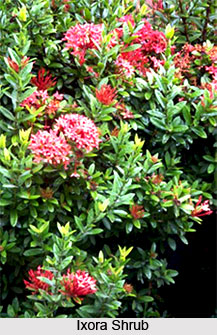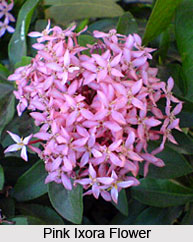 Being named as `Ixora Coccinea` in science, the `Ixora Shrub` is a very nice garden Shrub. The name `Ixora` derived from a Sanskrit word "ikvana" that is the name of a Malaysian deity, or possibly it derived from the name "Iswara", a Malabar deity to whom flowers were offered. The word `Coccinea` means "scarlet." The Shrub has several names in different languages of India. In both the languages of Hindi and Bengali, it is known as `Kangan`. In Marathi, it is called as `Bakora` while it is `Vedchi` in Tamil. In Malayalam language, people call it in two names as `Thetti` and `Chethi`. The Shrub is known as the `Scarlet Ixora` or `Flame of the Woods` or `Jungle Flame` or `Jungle Geranium` in English.
Being named as `Ixora Coccinea` in science, the `Ixora Shrub` is a very nice garden Shrub. The name `Ixora` derived from a Sanskrit word "ikvana" that is the name of a Malaysian deity, or possibly it derived from the name "Iswara", a Malabar deity to whom flowers were offered. The word `Coccinea` means "scarlet." The Shrub has several names in different languages of India. In both the languages of Hindi and Bengali, it is known as `Kangan`. In Marathi, it is called as `Bakora` while it is `Vedchi` in Tamil. In Malayalam language, people call it in two names as `Thetti` and `Chethi`. The Shrub is known as the `Scarlet Ixora` or `Flame of the Woods` or `Jungle Flame` or `Jungle Geranium` in English.
There are a lot of species of this very Shrub differing with each other in colours and sizes and that is why sometimes it becomes quite difficult for a person to identify them properly. The Shrub normally grows with some rough and grey coloured branches. They also bear some glossy stems that are of dark red colour. The leaves are silky and they appear in pairs. In some special occasions, they appear in threes as well. They are dark and shining and with definite veins, they are paler at the base. When the leaves are new, they got a clear, lucid lime green colour. Each of the flowers of the `Ixora Shrub` is a long and slender tube. The flower divides into four spreading petals. From the bases of these petals, four stamens bounce.  The flowers are collected in heads of different sizes. They are sometimes huge, round shaped full trusses and some other times, they are merely a group of a dozen or so. You will find all the shades and colours in this Shrub except the blues and purples. The flowers are very suitable for indoor decoration, as they remain fresh for a long time after plucking.
The flowers are collected in heads of different sizes. They are sometimes huge, round shaped full trusses and some other times, they are merely a group of a dozen or so. You will find all the shades and colours in this Shrub except the blues and purples. The flowers are very suitable for indoor decoration, as they remain fresh for a long time after plucking.
The Shrub flowers all through the year but during the Rainy season, it stays in its fullest bloom. The country people find a lot of medicinal uses for the various parts of the plant. The roots of the Shrub can be used as a medicine to lessen stomach troubles and cure dysentery. This Shrub is one of the smaller varieties of its family and can reach a mere height of above 150 cm. The flowers of the Shrub are radiant and they grow in large, compact heads. These heads are very much attractive during the monsoon. It can grow wild frequently in scrubby undergrowth, but in such conditions the flower heads remain much smaller. The fruit of the `Ixora Shrub` is usually black and similar to the size of cherry. It is very favourable to the peacocks. Some people claim that a extraction from the flowers or bark can relieve bloodshot eyes and also capable curing sores and ulcers. The Hindus think the bush as sacred to Shiva and Vishnu.











